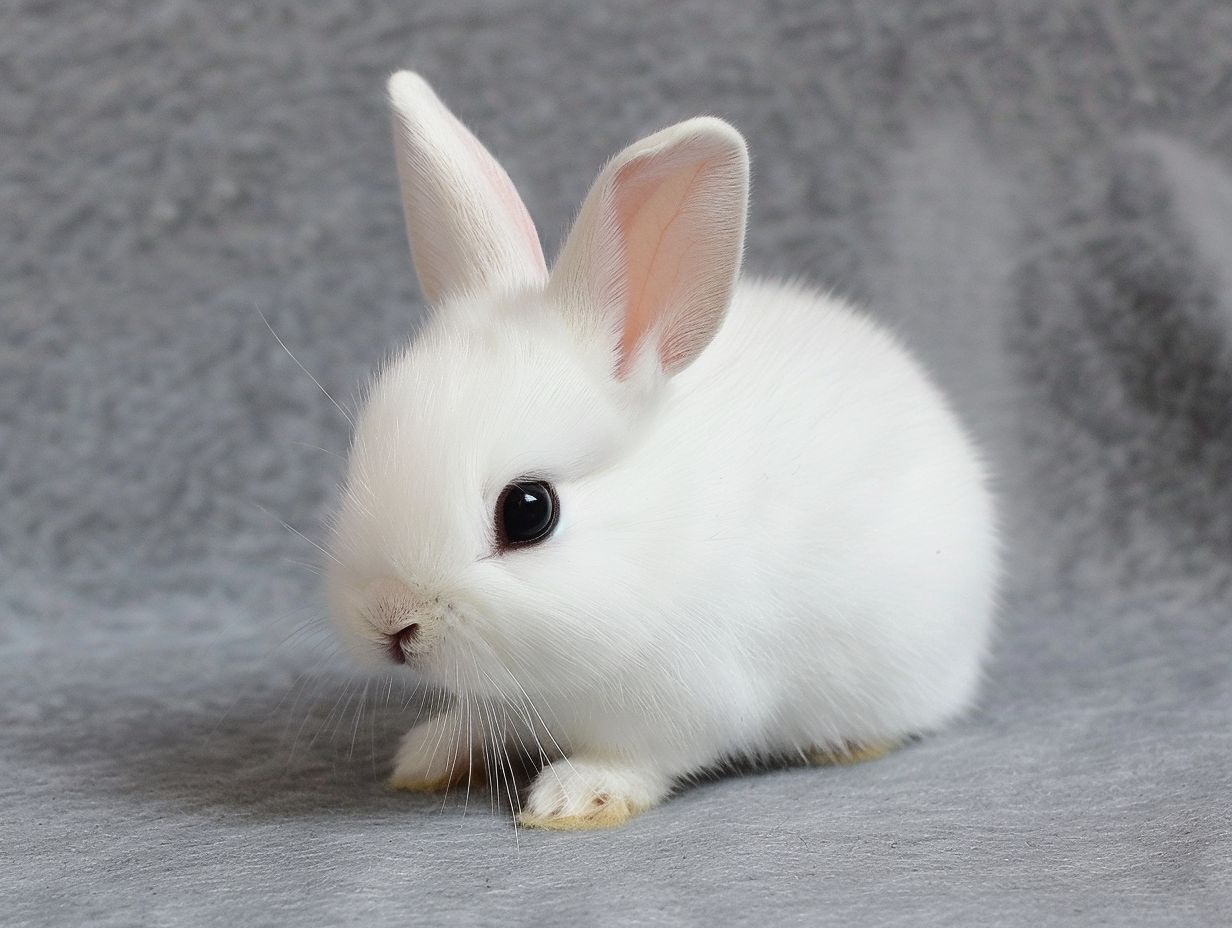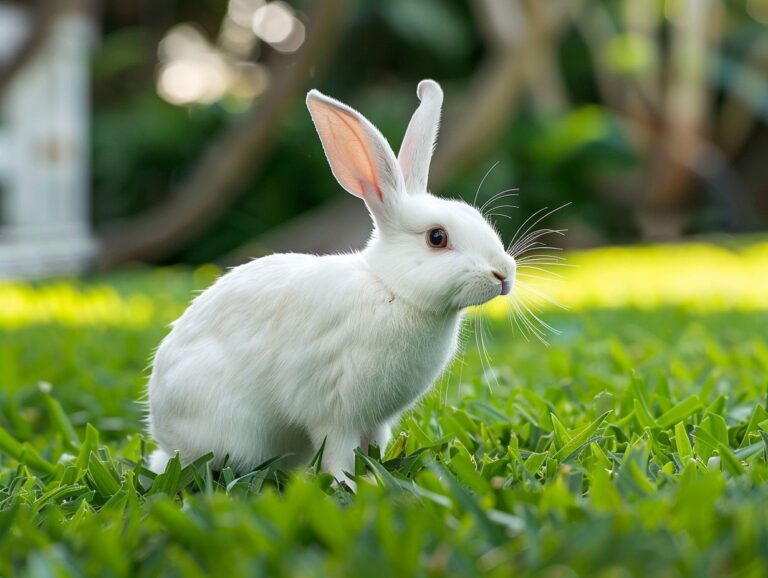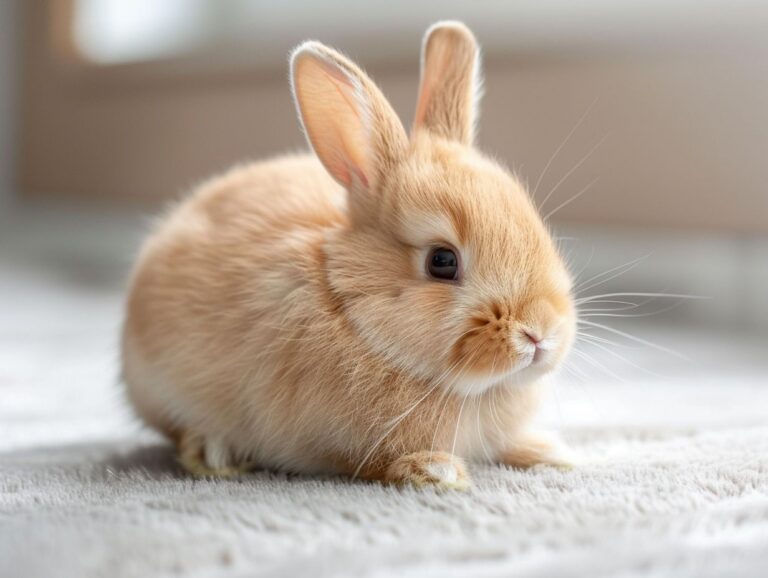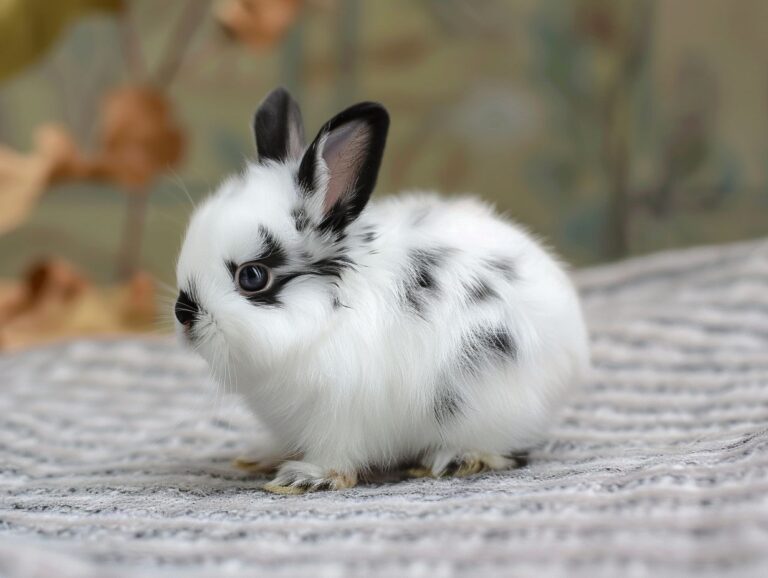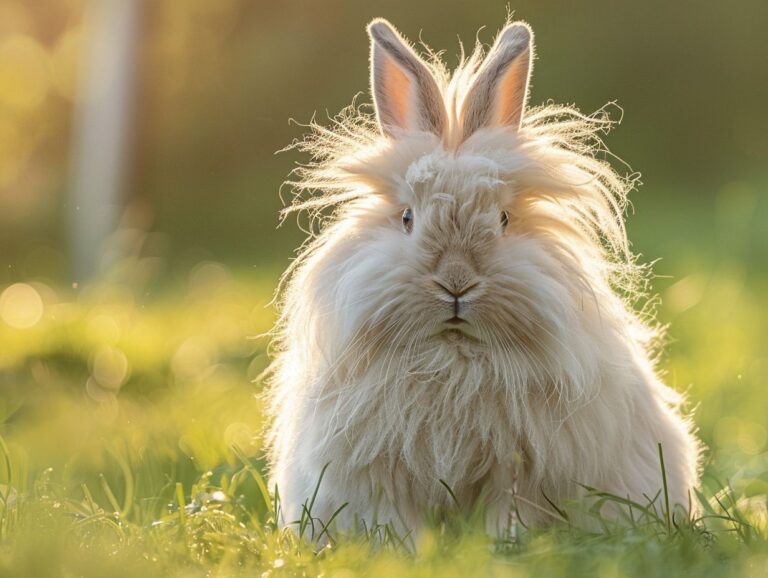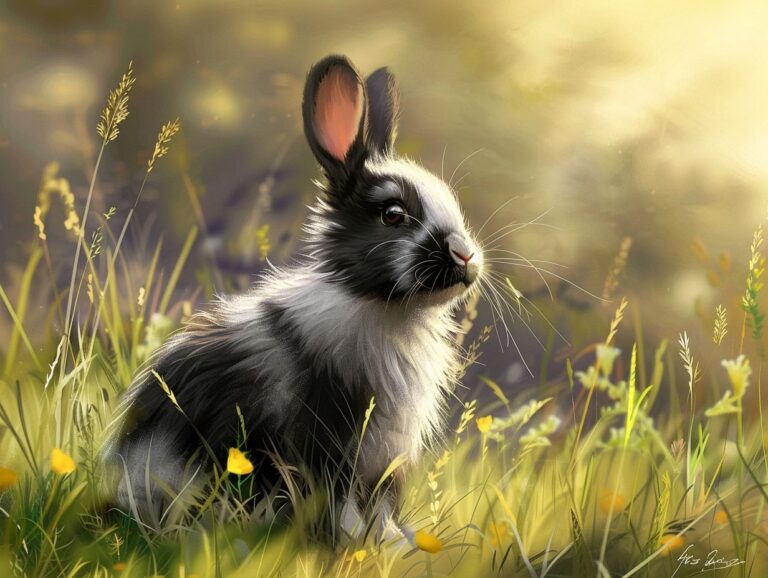Blanc De Hotot White Hotot Rabbit Breed: Characteristics, Care, History, and Breeding Practices
Are you looking to learn more about the Blanc de Hotot rabbit breed?
In this article, we will cover everything you need to know about these beautiful and unique rabbits.
From their appearance and size to their temperament and history, we will explore the fascinating characteristics of the Blanc de Hotot breed.
We will provide insights on how to care for these rabbits, including tips on housing, diet, grooming, and exercise.
We will discuss breeding practices for Blanc de Hotot rabbits, covering topics such as selecting breeding stock, the breeding process, and caring for newborn kits.
Whether you are a current Blanc de Hotot rabbit owner or simply curious about this breed, this article is sure to provide valuable information.
Key Takeaways:
What Is The Blanc de Hotot Rabbit Breed?
The Blanc de Hotot rabbit is a distinctive breed known for its stunning white coat and captivating eye bands. Originating in France, specifically in the Hotot-en-Auge region of Normandy, this breed has captured the admiration of rabbit breeders worldwide.
The breed’s hallmark feature is its pure white fur, contrasting beautifully with the striking black ‘eye bands’ that encircle each eye, giving them a unique and alluring appearance. These eye-catching markings are the reason behind their distinct allure.
With a rich history dating back to the early 1900s, the Blanc de Hotot rabbit was developed through careful breeding to achieve its signature look. The breed’s popularity has steadily grown over the years, especially among enthusiasts who appreciate its elegant and graceful demeanor.
What Are The Characteristics Of The Blanc de Hotot Rabbit Breed?
The Blanc de Hotot rabbit is renowned for its striking appearance, compact size, gentle temperament, and mesmerizing eye bands. These characteristics define the breed and contribute to its appeal among rabbit enthusiasts.
With a distinctly elegant presence, the Blanc de Hotot rabbit is medium-sized, weighing between 8 to 11 pounds when fully grown. Its compact, muscular body is beautifully complemented by a dense, plush coat of pure white fur. Known for their calm and friendly nature, these rabbits make excellent pets, often forming strong bonds with their owners.
One of the standout features of the Blanc de Hotot is its unique eye bands, which encircle the eyes in a striking black ring, creating a captivating contrast against the white fur. This distinct marking gives the breed a look of perpetual surprise, adding to its charm and allure.
Appearance
The appearance of the Blanc de Hotot rabbit is characterized by its lustrous white fur, distinct eye bands, and exquisite eyeliner marking. These features give the breed a sophisticated and elegant look that sets it apart from other rabbit breeds.
The soft and dense fur of the Blanc de Hotot rabbit has a velvety texture, adding to its charm and elegance. The striking contrast between the pure white fur and the deep black eye bands creates a mesmerizing effect that captures attention instantly. The eye bands encircling the eyes are meticulously defined, enhancing the rabbit’s facial features with a touch of mystery and allure.
The delicate eyeliner markings that adorn the Blanc de Hotot rabbit’s eyes are like a fine stroke of art, accentuating the eyes and giving them a captivating appeal. This breed’s unique appearance is further accented by the harmonious blend of these features, making it a truly enchanting sight.
Size
The Blanc de Hotot rabbit is a breed of small to medium size, often compared to Netherland dwarfs due to their compact build. This size is influenced by the breed’s genetics and selective breeding practices over the years.
Blanc de Hotot rabbits typically weigh between 8 to 11 pounds, making them slightly larger than Netherland dwarfs which usually range from 1.1 to 2.5 pounds. One of the significant factors affecting the size of Blanc de Hotots is their genetic makeup. Genetic variations play a crucial role in determining the size of these rabbits, influencing traits like bone structure, body proportions, and overall weight.
Temperament
The Blanc de Hotot rabbit possesses a gentle and friendly temperament that complements its elegant appearance. This breed is known for being sociable and affectionate, making them wonderful companions for families seeking a loving pet.
The Blanc de Hotot enjoys interactive playtime and bonding with their human family members, often seeking out attention and affection. Their sociable nature makes them well-suited for households with children, as they are patient and gentle in their interactions.
When cared for properly, these rabbits can thrive in a home environment, forming strong bonds with their owners. It’s important to provide them with a spacious living area, enriching toys, and a balanced diet to ensure their well-being and happiness. Regular grooming and veterinary check-ups are also essential to maintain their health and longevity.
What Is The History Of The Blanc de Hotot Rabbit Breed?

Eugenie Bernhard, a skilled breeder with a keen eye for unique traits, sought to create a distinctive breed with striking characteristics. By combining the elegance of Papillon rabbits with the snowy white coat of White Vienna rabbits, she laid the foundation for what would later be known as the Blanc de Hotot. This breed’s striking appearance, characterized by its pristine white fur and distinctive black eye rings, quickly caught the attention of rabbit enthusiasts in France.
The Blanc de Hotot became a symbol of elegance and sophistication, gaining popularity not only in France but also around the world. Its unique appearance and gentle temperament make it a favored choice among rabbit fanciers, and its recognition by international rabbit breeding associations further solidified its status as a prominent breed within the rabbit breeding community.
How To Care For A Blanc de Hotot Rabbit?
Caring for a Blanc de Hotot rabbit involves providing a suitable environment, regular grooming, a balanced diet, and a safe hutch. These steps ensure the well-being and comfort of your rabbit, making them ideal indoor pets.
In terms of grooming, Blanc de Hotot rabbits have a beautiful white coat that requires regular brushing to prevent mats and keep their fur in pristine condition. Additionally, ensuring that their nails are trimmed is crucial to avoid overgrowth and potential discomfort.
As for their dietary needs, these rabbits require a diet rich in hay, fresh vegetables, and a small amount of pellets. Providing ample fresh water is essential for their hydration and overall health.
When housing a Blanc de Hotot rabbit in a hutch, make sure it is spacious enough to allow for hopping and stretching. Incorporating bedding materials such as hay or straw provides a comfortable living environment.
To keep Blanc de Hotot rabbits happy as indoor pets, offer them plenty of opportunities for exercise, mental stimulation, and social interaction. Providing chew toys and safe hiding spots can contribute to their well-being and prevent boredom.
Housing
Proper housing for a Blanc de Hotot rabbit includes a spacious hutch, such as the Aivituvin Rabbit Hutch, that provides a safe and enriching environment for your pet. Ensure the cage is large enough for exercise and includes cozy spaces for rest.
Blanc de Hotot rabbits, known for their striking appearance with white fur and dark eye rings, require specific housing needs to thrive in captivity. The Aivituvin Rabbit Hutch, designed with high-quality materials, offers durability and functionality for these delicate creatures. When selecting a hutch, consider factors like ventilation, insulation, and predator protection to keep your rabbit safe.
Environmental considerations are vital; place the hutch in a shaded area to avoid overheating and ensure proper air circulation. Provide a solid flooring to prevent injuries to their delicate feet, and use non-toxic bedding materials for comfort. Ideal cage size guidelines recommend a minimum of 4 square feet of living space, with additional levels or hiding spots for mental stimulation.
Diet
A nutritious diet is essential for the health of a Blanc de Hotot rabbit. Include high-quality rabbit food like Wild Harvest Advanced Nutrition Diet For Rabbits to ensure they receive the necessary nutrients for optimal health. Grooming is also essential to maintain their lustrous fur.
Blanc de Hotot rabbits have specific dietary needs that must be met to keep them healthy and thriving. The Wild Harvest rabbit food provides a balanced mix of vitamins, minerals, and fiber crucial for their digestion and overall well-being. A diet rich in hay, vegetables, and a controlled portion of pellets is ideal for these rabbits.
Proper grooming plays a significant role in the maintenance of their stunning fur. Regular brushing helps prevent matting and keeps their coat clean and shiny. This practice also allows for early detection of any skin issues or parasites that may affect their health.
Grooming
Regular grooming is crucial for Blanc de Hotot rabbits to keep their coat and fur in excellent condition. Brushing their fur gently helps prevent matting and maintains the lustrous quality of their coat, promoting overall health and well-being.
Regular grooming sessions provide an opportunity to check for any signs of health issues such as skin irritations, parasites, or wounds, allowing rabbit owners to address them promptly. A gentle brushing routine also helps in distributing natural oils throughout the fur, keeping it soft and shiny. It is advisable to use a soft-bristled brush or a grooming glove to remove loose fur and prevent hairballs. Proper grooming not only enhances the appearance of Blanc de Hotot rabbits but also strengthens the bond between owners and their furry companions.
Exercise
Providing ample opportunities for exercise and mental stimulation is vital for Blanc de Hotot rabbits. Include toys in their living space to keep them engaged, promote physical activity, and enhance their overall well-being. Their trainability makes exercise routines enjoyable for both rabbits and owners.
Blanc de Hotot rabbits are naturally curious and playful animals, so incorporating a variety of toys is essential to keep them mentally stimulated and physically active. From chew toys to tunnels, puzzle feeders to balls, there are numerous options available to cater to their exercise needs. It’s important to create a stimulating living space by providing opportunities for exploration and interaction. This can include setting up obstacle courses, hiding treats around their space, or introducing new toys regularly to prevent boredom.
What Are The Breeding Practices For Blanc de Hotot Rabbits?

When selecting breeding stock for Blanc de Hotot rabbits, breeders meticulously evaluate traits like fur quality, body shape, and eye bands as per the breed standard.
Proper breeding protocols include introducing the doe to the buck in a neutral territory to prevent aggression. During pregnancy, it is crucial to provide a stress-free environment, a balanced diet, and regular veterinary check-ups. Careful monitoring during birth ensures the safety of both the mother and the kits.
Weaning is a gradual process that involves introducing solid foods and monitoring the kits’ development.
Selecting Breeding Stock
Choosing the right breeding stock for Blanc de Hotot rabbits is crucial to maintain breed standards and genetic diversity. Breeders often look for specific traits and characteristics that align with the guidelines established by the American Rabbit Breeders Association (ARBA).
When selecting breeding stock for Blanc de Hotot rabbits, breeders prioritize compact body size, distinct eye bands, and a snowy white coat with a well-defined circle around each eye. These rabbits should also exhibit a gentle and curious temperament, making them suitable for both show purposes and as family pets. Genetic diversity plays a vital role in ensuring the long-term health and vigor of the breed, so breeders carefully consider the heritable traits and potential genetic health issues when making their selections. By following ARBA guidelines, breeders help preserve the unique characteristics that define the Blanc de Hotot breed.
Breeding Process
The breeding process for Blanc de Hotot rabbits involves careful planning, monitoring, and providing optimal care for both the doe and the buck. Genetics play a significant role in determining the traits passed on to the offspring.
When planning breeding cycles for Blanc de Hotot rabbits, it is crucial to consider factors like age, health, and genetic diversity of the rabbits. Breeders need to ensure proper nutrition and a stress-free environment to increase the chances of successful reproduction.
Reproduction care involves monitoring the doe’s reproductive cycle, providing suitable nesting materials, and ensuring a comfortable birthing environment. Genetic considerations, such as selecting for desirable traits and avoiding genetic defects, are essential to produce healthy and high-quality offspring.
Caring For Pregnant Does
Providing proper care for pregnant Blanc de Hotot does is essential to ensure a successful pregnancy and birth. Monitoring their health, nutrition, and environment is crucial during this sensitive period, following guidelines set by organizations like the American Rabbit Breeders Association (ARBA).
Health monitoring for pregnant Blanc de Hotot does involves regular check-ups to assess their overall well-being, paying close attention to weight gain, behavior changes, and any signs of illness. Ensuring they have access to fresh water and a balanced diet rich in hay, vegetables, and high-quality pellets is important to meet their nutritional needs. Creating a comfortable and stress-free environment, with adequate nesting materials and a quiet, secluded area for them to rest, contributes to a smooth and healthy pregnancy journey.
Caring For Newborn Kits
Caring for newborn Blanc de Hotot kits requires attention to detail, warmth, and proper feeding. Ensuring their health and well-being is essential, with a focus on preventing common issues like GI stasis that can affect young rabbits.
In terms of warmth, provide a cozy nesting area using soft bedding material. Monitoring their temperature closely is crucial, as newborn kits are susceptible to chilling.
For feeding, nurse them every few hours with the mother’s milk, as it provides essential nutrients and antibodies for their developing immune system.
Regularly checking for signs of illness, such as lethargy or abnormal stool, aids in early detection of health issues.
Preventing GI stasis involves offering a diet rich in hay and ensuring they stay hydrated to promote proper digestion.
Raising and Weaning Kits
Raising and weaning Blanc de Hotot kits requires gradual transitions and attentive care to ensure their growth and development. Providing a nurturing environment and proper training are essential aspects of raising healthy and well-adjusted rabbits.
When initiating the weaning process, it is crucial to introduce solid foods gradually while maintaining access to the mother’s milk for a smooth transition. Encourage the kits to explore and nibble on hay, fresh vegetables, and specialized pellets to diversify their diet. Consistency in feeding schedules and monitoring their intake is key to preventing digestive issues during this transition phase. Engaging the kits in gentle handling and socialization exercises from a young age helps in their emotional development, ensuring they grow up to be friendly and sociable rabbits.
Preventing Inbreeding

Preventing inbreeding in Blanc de Hotot rabbits is essential to maintain genetic diversity and reduce the risk of inherited health issues. Following guidelines from organizations like the American Rabbit Breeders Association (ARBA) helps breeders make informed decisions to preserve the breed’s health and vitality.
Genetic homogeneity caused by inbreeding can lead to a higher incidence of genetic abnormalities and reduces the overall resilience of the breed. By adhering to ARBA guidelines, breeders can introduce new bloodlines and avoid mating closely related rabbits, thus safeguarding the Blanc de Hotot population from the negative effects of inbreeding depression. Consistent monitoring of pedigrees and health records is crucial in ensuring the long-term sustainability and well-being of this unique breed.
Frequently Asked Questions
What is the Blanc de Hotot (White Hotot) Rabbit Breed?
The Blanc de Hotot (White Hotot) Rabbit Breed is a medium-sized breed of domestic rabbit known for its distinctive white fur with black markings on the nose, ears, and feet. They have a compact and well-rounded body shape and are known for their docile, calm temperament.
What are the characteristics of the Blanc de Hotot (White Hotot) Rabbit Breed?
The Blanc de Hotot (White Hotot) Rabbit Breed is known for its distinctive white fur with black markings, which is their most notable characteristic. They have a medium-sized, compact body with a well-rounded shape. They also have a gentle and calm temperament, making them great pets for families.
How do I care for a Blanc de Hotot (White Hotot) Rabbit?
To care for a Blanc de Hotot (White Hotot) Rabbit, you should provide them with a spacious and clean cage, a balanced diet of hay, pellets, and fresh vegetables, and regular grooming to keep their fur clean and healthy. They also need regular exercise and plenty of fresh water to stay hydrated.
What is the history of the Blanc de Hotot (White Hotot) Rabbit Breed?
The Blanc de Hotot (White Hotot) Rabbit Breed originated in France in the early 20th century. It was created by crossing the Checkered Giant and the Blanc de Bouscat breeds to produce a rabbit with a unique white fur pattern. They were primarily bred for their meat and fur, but have gained popularity as pets in recent years.
What are the breeding practices for the Blanc de Hotot (White Hotot) Rabbit Breed?
The Blanc de Hotot (White Hotot) Rabbit Breed is known for being relatively easy to breed. They are able to reproduce at a young age and have large litter sizes, with an average of 7-9 kits per litter. It is important to select healthy and genetically diverse breeding pairs to maintain the health and quality of the breed.
Are there any health concerns associated with the Blanc de Hotot (White Hotot) Rabbit Breed?
Like all rabbit breeds, the Blanc de Hotot (White Hotot) Rabbit can be prone to certain health issues such as dental problems and gastrointestinal issues. It is important to provide them with a proper diet, regular exercise, and annual check-ups with a veterinarian to ensure their overall health and well-being.

